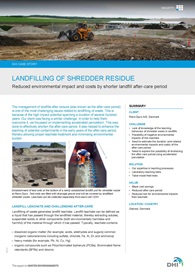Landfilling of shredder residue
We helped our client focus on implementing accelerated percolation in their landfill. This was done to effectively shorten the landfill after-care period.
 We helped our client focus on implementing accelerated percolation in their landfill. This was done to effectively shorten the landfill after-care period. It also helped to enhance the leaching of potential contaminants in the early years of the after-care period, thereby allowing proper leachate treatment and minimising environmental burden.
We helped our client focus on implementing accelerated percolation in their landfill. This was done to effectively shorten the landfill after-care period. It also helped to enhance the leaching of potential contaminants in the early years of the after-care period, thereby allowing proper leachate treatment and minimising environmental burden.
Landfilling of waste generates landfill leachate. If leachate is managed incorrectly or ineffectively, there is a high risk of soil and groundwater contamination during the operational time as well as after closure. Experience shows that unless a proactive approach is taken in the after-care period to stimulate the leaching process, it may take up to several hundred years for some contaminants to reach environmentally acceptable levels in the leachate. For any landfill operator, such a long period is both technically and economically unacceptable.
In order to help our client overcome this challenge, we used our expertise in leaching processes, laboratory leaching tests and tailor-made field tests. In so doing, we helped them by:
- providing accurate estimates of the duration of the after-care period for different leachate generation scenarios
- proposing a solution for shortening the after-care period
Our evaluations showed that the after-care period can be reduced to less than 100 years if leaching is accelerated. We showed that controlled infiltration of substantial amounts of water could potentially reduce the after-care period even further – to about 30 years.
Read more